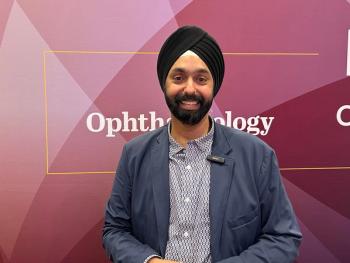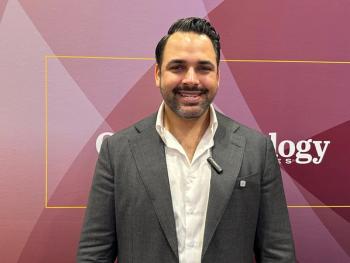
Innovator’s Lecture focuses on ‘Collaborative Innovation’
Retina specialist Ron M. Kurtz, MD, details the way collaborative innovation can improve the lives of ophthalmic surgeons, and their patients.
The 2019 ASCRS Charles D. Kelman, MD, Innovator’s Lecture was delivered Monday
In her introduction of Dr. Kurtz, Ann Kelman described him as a “true entrepreneur and collaborator extraordinaire.”
A retina specialist by training, Dr. Kurtz is perhaps best known for his innovative work with femtosecond lasers. Taking a hiatus from that field four years ago, Dr. Kurtz became involved with the development of adjustable IOL technology and is now the president and CEO of
In his lecture, Dr. Kurtz used his personal observations and experiences developing these ophthalmic tools over the last 25 years to outline the innovative process, the power of collaboration, and the impact of collaborative innovation for improving the lives of ophthalmic surgeons and their patients.
Basic definitions and descriptions
Dr. Kurtz began by distinguishing between invention and innovation.
“Invention is a new product or process. Innovation is the application of the invention to address a need and create value,” he said.
Explaining the importance of collaboration, he said that innovation starts with an invention, but improving the product’s performance requires further development that is generally accomplished through the work of a multidisciplinary team. Through the efforts of the collaborators, the innovation is eventually commercialized where it can benefit from marketplace innovation.
“Marketplace innovation occurs as different groups with different needs and requirements make changes to the technology in order to make it useful for their practices and patients,” said Dr. Kurtz.
“That process needs to be accounted for and is accounted for in our regulatory system and in the whole product development process.”
Collaborative innovation
In addition, Dr. Kurtz said there can be collaborative innovation between technologies in which a particular technology reaches a certain level of use, but additional technology enables its further clinical adoption. He referred to phacoemulsification as a good example of collaborative innovation.
“The adoption of phacoemulsification was definitely helped by the development of viscoelastics and folding IOLs,” Dr. Kurtz said.
Personal illustrative examples
Noting that he first got into clinical ophthalmology in the early 1990s, Dr. Kurtz said that the process of collaborative innovation was then taking place in the field of refractive corneal surgery where LASIK was introduced as the product of combining the excimer laser with the technique and principles of keratomileusis.
At the same time, picosecond (femtosecond) laser intrastromal ablation was also vying for space in refractive corneal surgery, and its further development might have met a dead end if it were not for work being done at by Gerard Mourou, PhD, who developed the first high power femtosecond laser. Dr. Mouro founded a research center at the University of Michigan where Dr. Kurtz was in his residency.
Dr. Kurtz said that his experience seeing a student with an accidental laser injury was the beginning for his interest in the femtosecond laser. It led him to begin working on some basic studies and to a collaboration with Dr. Mouro and Tibor Juhasz, PhD, that culminated in joining of the picosecond and femtosecond laser technologies.
“Research showed that a number of corneal applications could be performed better and more efficiently with the femtosecond laser,” Dr. Kurtz explained.
Overcoming challenges
The quest to commercialize the femtosecond laser brought a number of technical and clinical challenges that were successfully overcome thanks to the work of collaborators around the world.
“Together we made the advances necessary to introduce the technology into the marketplace in 2002. Then the technology underwent a series of marketplace innovations that were driven by the need to improve resection quality for better postop day 1 vision and the reliability of the system,” Dr. Kurtz said.
As described by Dr. Kurtz, the history of refractive cataract surgery further illustrates the process of collaborative innovation. He noted that the refractive focus in cataract surgery started with the development of the first intraocular lenses, was subsequently aided by Dr. Kelman’s development of phacoemulsification, and then by the work of others working on improving diagnostics and IOL power formulas among other factors. Medicare reimbursement policies alternately served to fuel, slow, and then stimulate innovation once again.
“The CMS Dual Aspect rules that came into play in 2005 and 2006 resulted in a new level of innovation with presbyopia- and astigmatism-correcting IOLs and led to innovations in diagnostics and surgical technologies. Then our team and others thought about applying the precision of femtosecond lasers to cataract surgery,” Dr. Kurtz said.
The development challenges were even greater than those faced with the initial development of the laser for corneal surgery, but they were overcome thanks to the efforts of a multidisciplinary team. In 2012, the technology was introduced into the marketplace, and it has subsequently benefited from the process of marketplace driven innovation.
“In addition, the world of femtosecond laser ophthalmic applications is continuing to increase, and I am happy to report this contribution from ophthalmology was recognized
New focus for innovation
Briefly discussing his involvement with adjustable IOL technology, Dr. Kurtz said he was intrigued by its ability as an office-based system to optimize vision after cataract surgery and potential to overcome the limitations of both preoperative and intraoperative processes. As of 2019, the LAL is approved in the United States, Mexico, and Europe and is beginning to go through the process of marketplace innovation.
Concluding thoughts
Dr. Kurtz said that as he was doing research for his talk, he came across a quote from Manus Kraff, MD. Discussing the genesis of the ASCRS, Dr. Kraff noted that it was formed to satisfy a need not being met in ophthalmology where by tradition, clinical ophthalmologists were not supposed to be innovative.
“Clearly that is a need that the society through this lectureship and others continues to serve,” Dr. Kurtz said. He closed by showing a note he received from the late Lee Nordan, MD, that was written in May, 2000, after Dr. Nordan performed his first femtosecond laser LASIK flap procedures. The note said, “Dear Ron, The quest for excellence never ceases.”
“That is true today as well, and I am thankful for the experiences I had with Lee and for this great honor,” Dr. Kurtz concluded.
Newsletter
Don’t miss out—get Ophthalmology Times updates on the latest clinical advancements and expert interviews, straight to your inbox.



















































.png)


